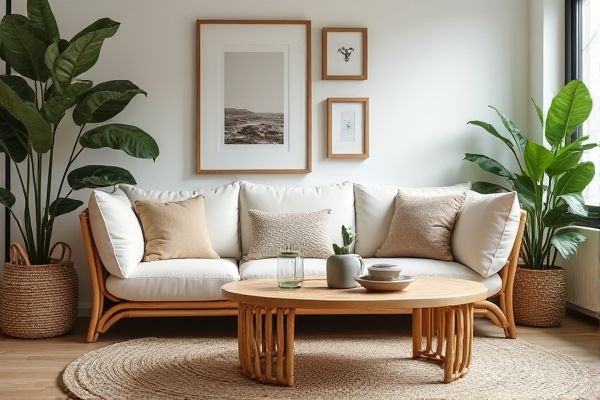
Rattan furniture is crafted from the naturally sturdy stems of the rattan palm, offering durability and a smooth, lightweight finish, while wicker furniture refers to the weaving technique using materials like rattan, bamboo, or synthetic fibers, resulting in varied textures and patterns. Discover how to choose the best option for your outdoor or indoor space by exploring the differences in maintenance, style, and longevity in the rest of the article.
Table of Comparison
| Aspect | Rattan Furniture | Wicker Furniture |
|---|---|---|
| Material | Natural rattan vine, a strong woody plant | Craft technique, usually woven from rattan, reed, bamboo, or synthetic fibers |
| Durability | Highly durable and strong, suited for indoor use | Varies based on material; synthetic wicker is weather-resistant, natural is less durable outdoors |
| Appearance | Smooth, solid texture with natural grain | Textured, intricate weaving pattern |
| Weight | Lightweight but sturdy | Lightweight, flexible due to weave |
| Maintenance | Requires occasional cleaning and conditioning | Synthetic wicker is low maintenance; natural needs care to prevent damage |
| Cost | Generally higher due to natural material and durability | Varies widely; synthetic options are affordable, natural wicker is mid to high price |
| Best Use | Indoor furniture, some outdoor if protected | Outdoor and indoor furniture depending on material |
Introduction to Rattan and Wicker Furniture
Rattan furniture is crafted from the natural vine of the rattan palm, known for its durability, flexibility, and lightweight properties, making it ideal for both indoor and outdoor use. Wicker furniture, on the other hand, refers to the weaving technique applied to materials like rattan, bamboo, or synthetic fibers, emphasizing craftsmanship and design variety. Understanding the distinction between rattan as a raw material and wicker as a weaving method is essential for selecting furniture based on durability, style, and maintenance preferences.
What is Rattan Furniture?
Rattan furniture is crafted from the natural vine-like palm found in tropical regions, known for its durability and lightweight structure. The core of rattan stems is used to create solid, sturdy frames that are resistant to wear and environmental elements. This type of furniture often boasts a smooth finish, making it ideal for both indoor and outdoor use.
What is Wicker Furniture?
Wicker furniture refers to pieces crafted through a weaving process using flexible plant materials such as rattan, bamboo, or synthetic fibers. This technique emphasizes the interlacing of strands to create lightweight, durable, and breathable furniture suitable for both indoor and outdoor use. Wicker's versatility allows for diverse designs and textures, distinguishing it from the solid framework characteristic of pure rattan furniture.
Key Material Differences: Rattan vs Wicker
Rattan furniture is crafted from the natural, durable stems of the rattan palm, known for strength and flexibility, whereas wicker refers to the weaving technique applied to various materials such as rattan, bamboo, or synthetic fibers. The primary distinction lies in rattan being a specific raw material, while wicker describes the method used to create furniture from different materials. Synthetic wicker, often made from resin or plastic, offers enhanced weather resistance compared to natural rattan, which requires careful maintenance to prevent damage.
Durability and Longevity Comparison
Rattan furniture is known for its natural strength and flexibility, offering superior durability and longevity, especially in indoor settings. Wicker furniture, often made from synthetic materials like resin or plastic, resists moisture and UV damage better, making it ideal for outdoor use and longer-lasting in harsh weather conditions. Your choice depends on whether you prioritize the sturdy, classic appeal of rattan or the weather-resistant benefits of synthetic wicker for lasting use.
Aesthetic Styles and Design Trends
Rattan furniture showcases natural, warm tones and a smooth, flexible texture that fits seamlessly into bohemian and coastal decor styles. Wicker furniture, which can be crafted from various materials like synthetic resin or bamboo, offers intricate weaves and durability, making it popular in traditional, rustic, and modern outdoor designs. Current design trends favor rattan for its eco-friendly appeal and handcrafted aesthetics, while wicker's versatility and ease of maintenance make it a staple in contemporary garden and patio settings.
Indoor vs Outdoor Suitability
Rattan furniture is ideal for indoor use due to its vulnerability to prolonged exposure to moisture and sunlight, which can cause it to weaken and deteriorate. Wicker furniture, often made from synthetic materials, offers superior durability and resistance to weather conditions, making it more suitable for outdoor settings. When choosing your furniture, consider rattan for stylish, comfortable indoor decor and wicker for weather-resistant outdoor living spaces.
Maintenance and Care Requirements
Rattan furniture requires regular dusting and occasional wiping with a damp cloth to prevent dirt buildup, while wicker furniture, often made from synthetic materials, is more resistant to moisture and easier to clean with soap and water. Both types benefit from avoiding prolonged exposure to direct sunlight to prevent fading and brittleness, but wicker's synthetic variants typically offer greater durability in outdoor environments. To maintain the appearance and longevity of your furniture, using protective covers and storing pieces indoors during extreme weather conditions is recommended.
Price and Value Analysis
Rattan furniture typically offers higher durability and a natural aesthetic but comes at a higher price point compared to wicker furniture, which is often more affordable due to its synthetic materials. Your choice depends on balancing budget constraints with long-term value, as rattan's strength and timeless appeal generally justify the initial investment. Wicker furniture provides cost-effective styling and lighter maintenance but may require more frequent replacement, impacting overall value.
Which is Better: Rattan or Wicker?
Rattan furniture, made from natural palm stems, offers superior durability and flexibility compared to wicker, which is a weaving technique that uses various materials like synthetic fibers or bamboo. Your choice depends on whether you prioritize the lightweight and moisture-resistant qualities of synthetic wicker or the authentic, sturdy feel of rattan. For long-lasting outdoor use, rattan's natural strength often outperforms wicker made from less robust materials.
 homyna.com
homyna.com